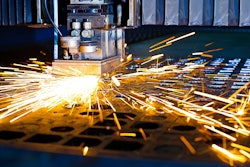BOSTON, MA — Industrial companies are facing critical challenges rooted in slow growth, globalization, the impact of disruptive technologies and unforeseen competitive threats. A new report from global management consulting firm L.E.K. Consulting reveals how those companies are responding — and what the response will mean for the future of companies around the globe in a range of manufacturing sectors.
A series of in-depth interviews with CEOs and senior executives at 17 major global industrial firms spotlight emerging trends that include new sales models and organizational structures, a sharper focus on high-yield parts of the value chain, adoption of disruptive technologies and shifts toward fast-cycle R&D. The findings are presented in the report, New Imperatives: Why Global Industrials Must Shift Strategic Priorities.
"In the face of strong headwinds, industrial businesses are making fundamental changes," says John Goddard, Senior Partner at L.E.K. Consulting and an author of the report. "The actions they are taking — reducing costs, re-examining their business models, building new capabilities and embracing new technologies — provide a road map for companies that are striving to respond to major challenges in multiple industrial sectors."
"All told, the industrials sector is under significant duress and, in many instances, may face a future with relatively limited growth prospects," adds Carol Wingard, Managing Director at L.E.K. Consulting. "However, while some businesses are less than sanguine about the medium-term outlook, others see opportunity on the horizon."
Among the factors affecting companies ranging from commodity producers to OEMs to distributors in multiple industrial sectors: End-buyers narrowing their lists of suppliers while demanding more customization, all in a weak pricing environment; sustained downward pressure on margins that demands cost reduction and productivity increases; value-chain disruption by new competitors leveraging technology and new business models, and high rates of innovation as companies under pressure seek more profit. Ownership structures are changing, with the emergence of new Asian owners, private equity and activist shareholders all playing major roles, thereby prompting corporate boards to re-examine their strategies.
In response, the report says, industrial businesses are making -- or should make -- fundamental changes:
- Redefine the sales model. How and what companies are selling have begun to change. They are moving toward "omnichannel" business models — combining physical, online and mobile channels, with extensive customization. This allows companies to deepen and broaden the customer experience by customizing pricing and selling solutions rather than products -- for example, providing data analytics as an extra. By tailoring offerings and pricing to specific customer situations — for example, lower overall price, whole-life costing models for capital goods or embedded process efficiency solutions -- they can strengthen relationships and protect margins. The report describes a company that sells equipment for stage productions to theaters, stadiums and broadcast studios. Instead of selling by product line — which led to multiple sales calls to the same customer — it shifted to a line-of-business sales model that helped it structure solution-oriented product packages.
- Optimize the value chain. Industrial organizations are taking a close look at where they participate in the value chain and focusing on those activities with the greatest potential for creating value. This is a fundamental change in the nature of what these companies do. Some are shifting toward greater product customization. Others are partnering and outsourcing to enhance their capabilities without taking on additional human capital. Still others are deploying selective forward integration — adding services or distribution — to get closer to the end customer. A crane manufacturer, for example, acquired the maker of the motor control systems that operate — and help differentiate — its products.
- Restructure and recruit. Companies are simplifying their organizational structures to increase agility and responsiveness. Many are adopting lean and agile organization design principles, shifting to small teams, organizing by function rather than by factory, and increased focus on Key Performance Indicators (KPIs) to drive performance. Industrial businesses are acutely aware of a looming talent shortage, as younger workers look to other sectors for their careers. They are therefore focused on developing new capabilities within their established workforces while retaining scarce skills. At the same time, they are creating strategies to "sell" their businesses to up-and-coming talent.
- Embrace disruptive technology. Disruptive technologies such as additive manufacturing, robotics and automation, and those related to the Industrial Internet of Things (IIoT), have the potential to transform industrial markets by reshaping demand for products and services — and, perhaps more critically, by redefining how those products and services are delivered, and by whom. And the rate at which these innovations are coming to market is increasing, intensifying their impact. Companies that do not understand their effect are at significant risk. However, for every loser there is a winner — those who embrace these disruptive technologies will gain competitive advantage. According to the CEO of a global supplier of metal molding and finishing equipment, new technologies are shifting the focus in his market away from selling physical equipment and toward marketing deep application expertise. Taken to the logical extreme, the future he envisions includes companies like Amazon or Google becoming aggregators of industrial design capability, with manufacturing undertaken locally using 3-D printing.
- Configure for fast-cycle R&D, innovation and technology adoption. Despite low growth in many industrials sectors, leading companies are looking for ways to innovate and bring products and solutions to market more quickly. Some are infusing their cultures with a more innovative mindset. Others are focused on leveraging external know-how to jumpstart innovation through partnerships with suppliers, government organizations and academic institutions. Another approach involves identifying and adopting ideas identified by others via innovation or crowdsourcing platforms. Energy giant Statoil has established "Innovate," a challenge-driven platform to connect with companies that are able to help find solutions for safe and sustainable energy production. Ford is a founding member of the Motor City Innovation Exchange, which acts as a public showroom and marketplace for startups to present emerging technologies to potential customers. General Motors' component strategy has three elements: build, buy and partner. The carmaker collaborated with LG, a key component supplier, to develop the Chevrolet Bolt EV, launched in 2015.
"The changes required to take advantage of these opportunities will be significant," Mr. Goddard says. "The necessary transformation will mean building new capabilities, revamping sales strategies, embracing new technologies, stepping up innovation, developing more agile and responsive organizational structures, and finding ways to expand into new markets and geographies. We believe that those companies that make the transformation will be able to enter the next industrial revolution with confidence."
L.E.K. Consulting is a global management consulting firm that uses deep industry expertise and rigorous analysis to help business leaders achieve practical results with real impact.






















